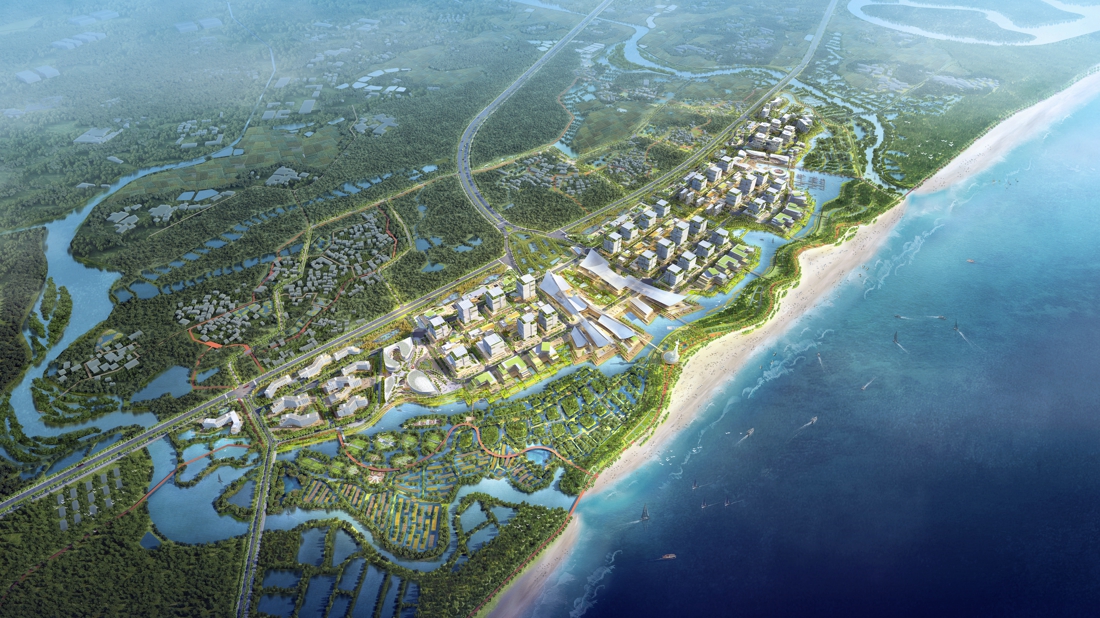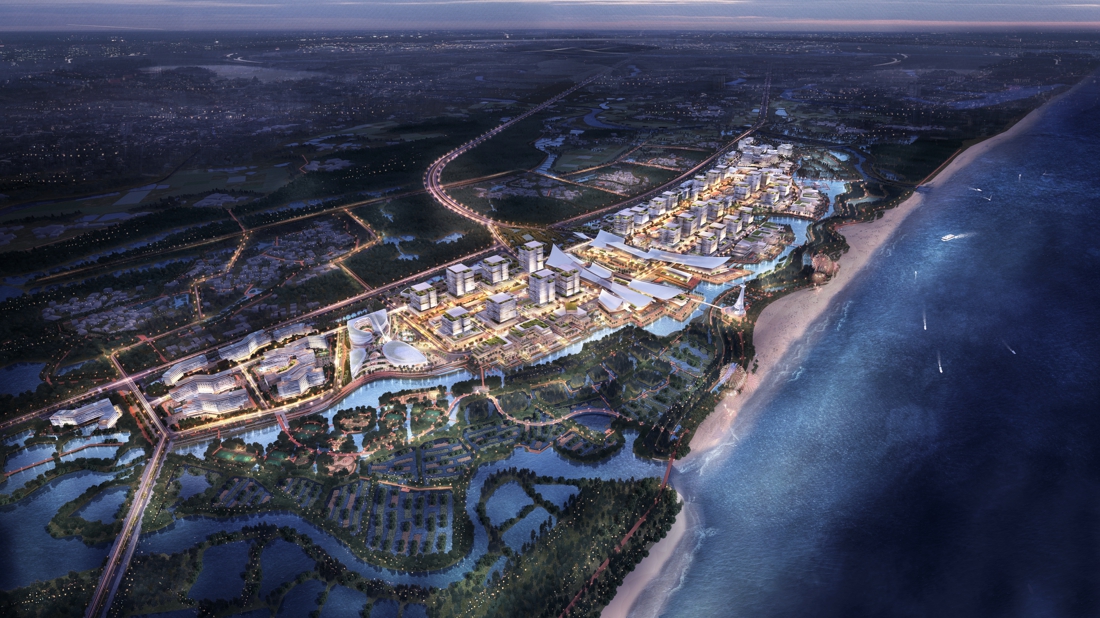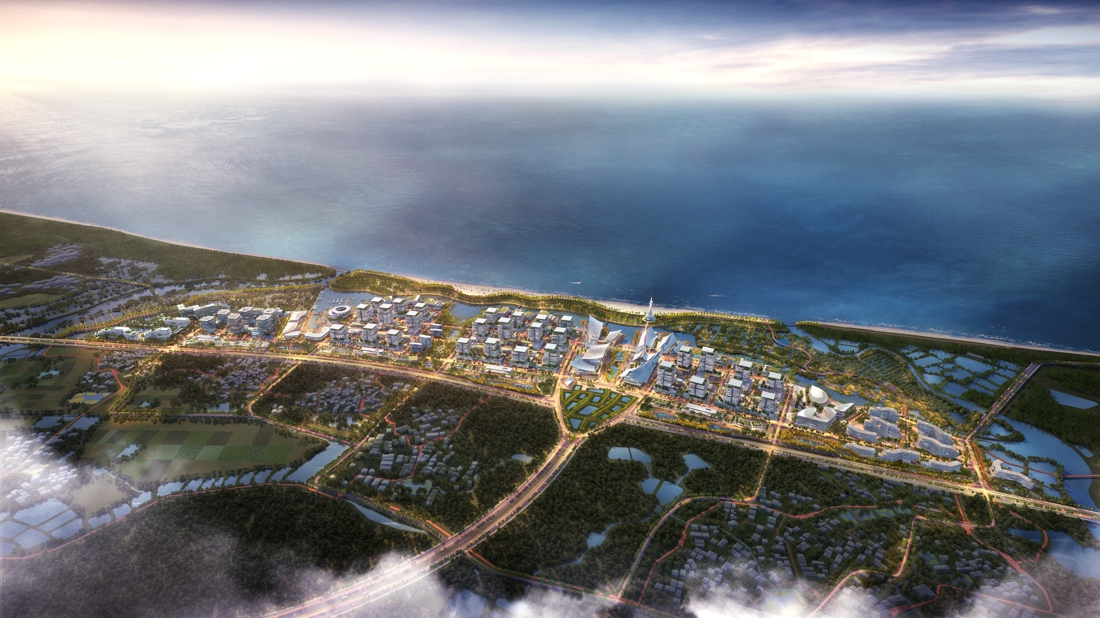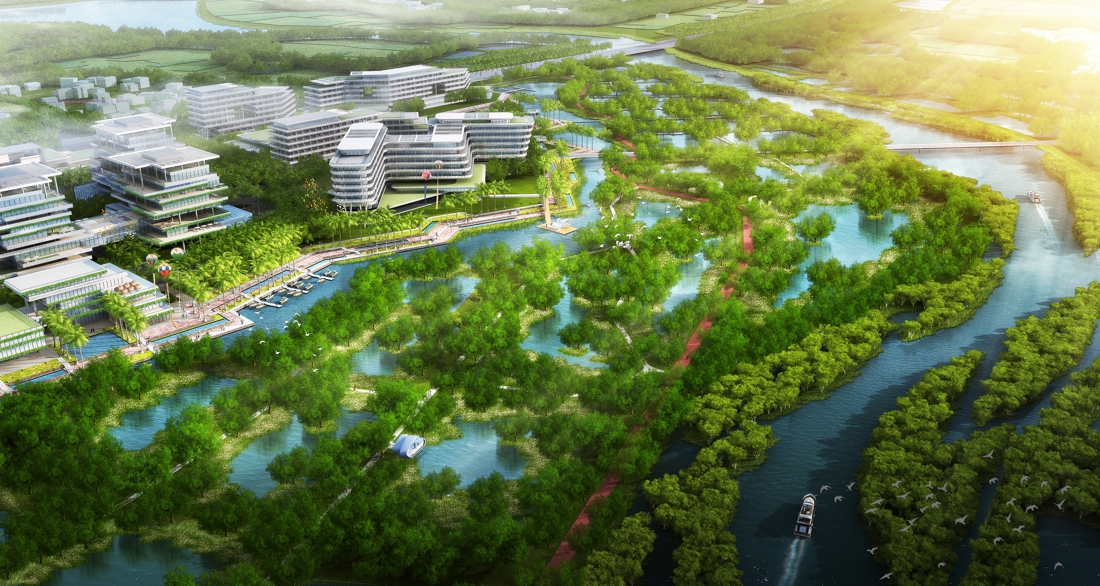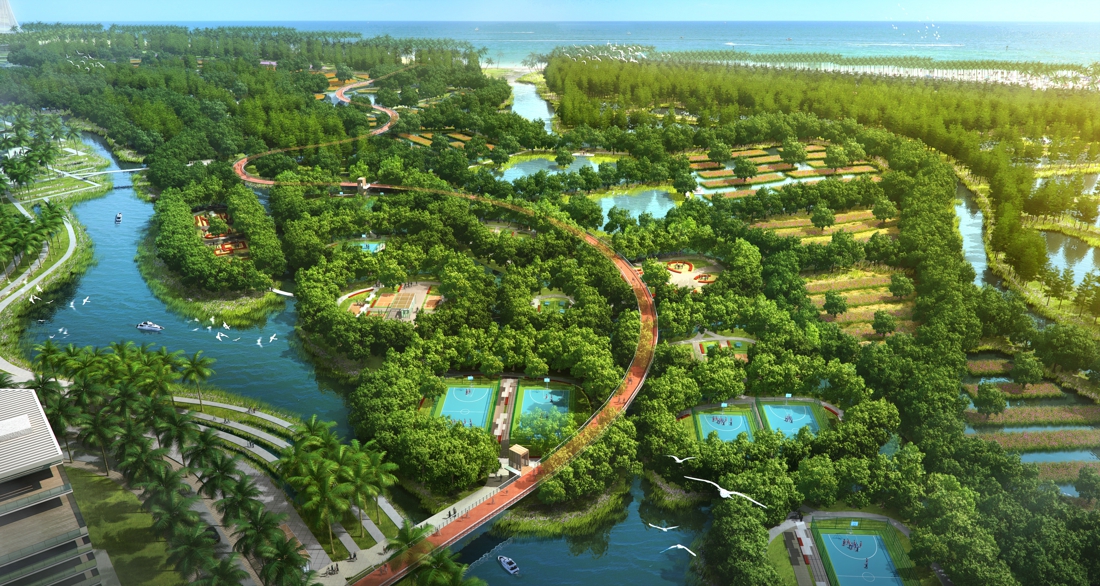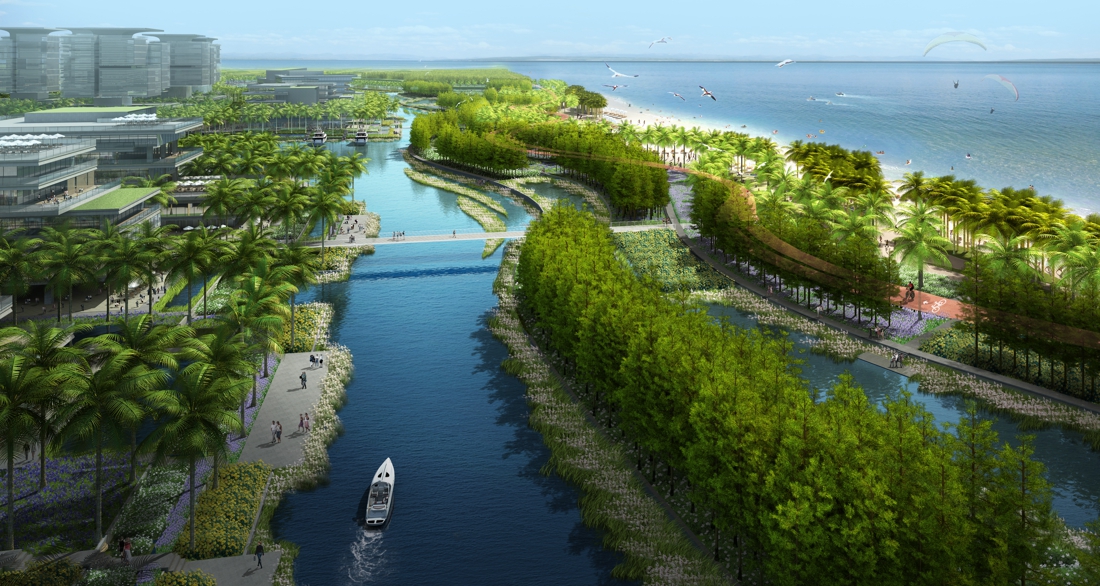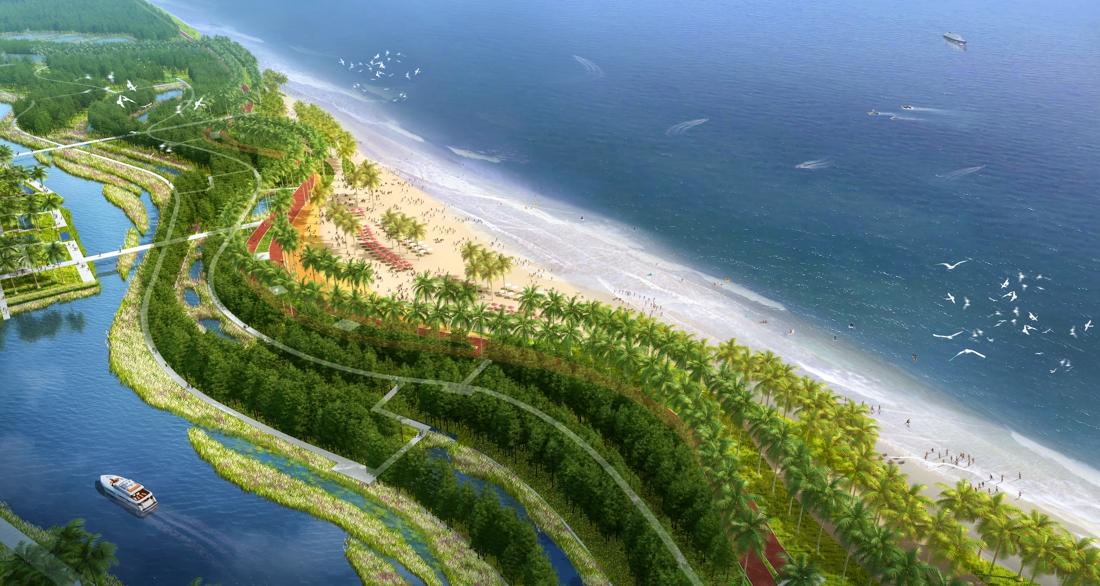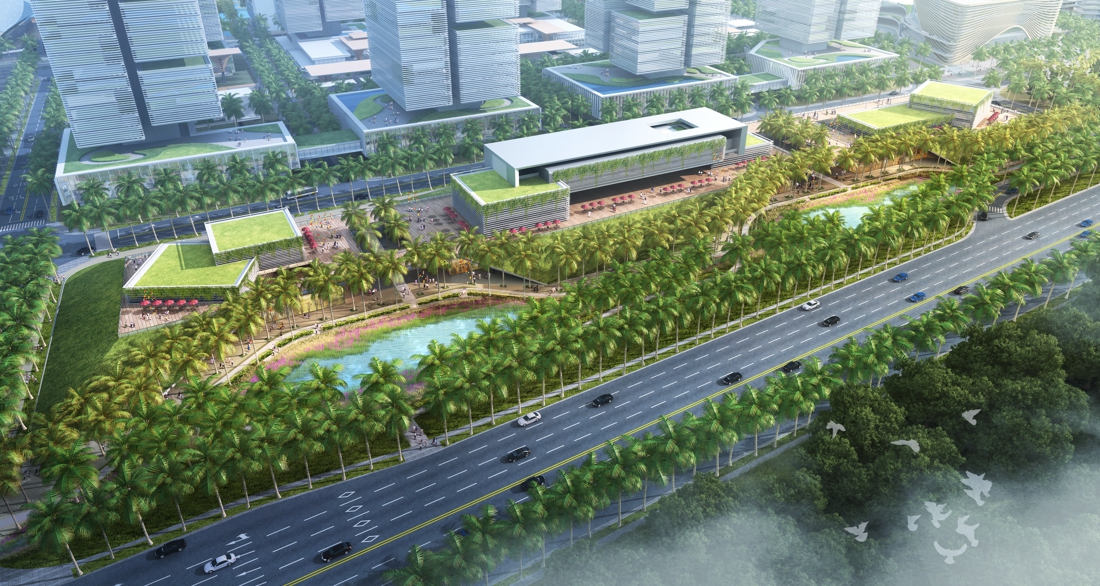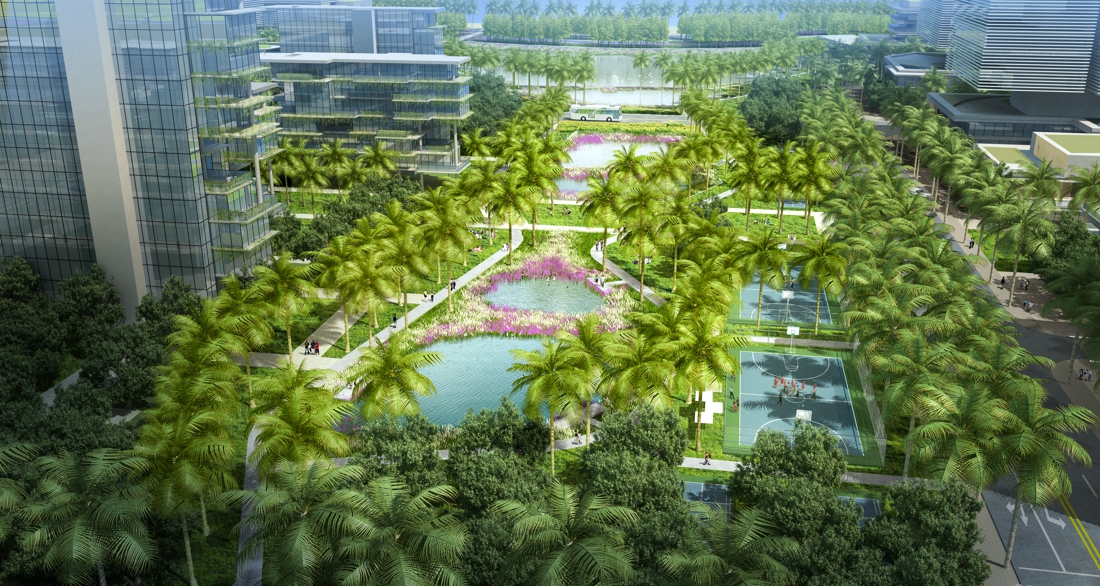Hainan Free Trade Zone Haikou Jiangdong New Area Urban Design
Project Information
- Project Location:
- China Haikou,Hainan
- Project Scale:
- 1.79 Square Kilometers
- Design Time:
- 2018
- Client:
- The leading group of Haikou Jiangdong New District, China(Hainan) Free Trade Zone
Project Profile
1.Project Statement
Design team: The design team of this project is cooperated between Architectural Design and Research of SCUT and Turenscape.
Project information: The Starting Area of Haikou Jiangdong New District is located at the intersection of Baiju avenue and Jiangdong avenue. The planned area starts from Furong river in the east to Daomeng river in the west. The north ends on the coastline, and Jiangdong avenue on the south, with a total area of 1.79 square kilometers.
Planning positioning: World-class ecological CBD. Jiangdong new district is the display window of China (Hainan) free trade zone and is a new benchmark for comprehensively deepening reform and opening up in the new era of hainan, displaying the Chinese style, Chinese manner and Chinese image. The starting zone is one of the development zones in Jiangdong new district. Therefore, its construction must focus on ecology and safty, advanced mode and future wisdom, to create a headquarters economic zone with good ecology and vitality and lead the regional development.
2.Objective and Challenge
Ecological security challenge: Haikou is located in a prone zone of typhoons and storm surges. According to the implementation rules for coastal protection and development management of Hainan special economic zone, within 200 meters of the coastal line is the key ecological zones which shall be controlled and protected, and all construction shall be prohibited. There are two fault zones around the site, including Xincun-Linwu fault, Manian-Puqian fault and Puqian-Qinglan fault. The east-west directed Xincun-Linwu fault is close to the site and has potential earthquake disaster risk. At the same time, the "Haikou Jiangdong new district starting area detailed planning engineering geological survey report" shows that part of the site is at risk of liquefaction of sand and soil. The once-in-a-century tide level is 3.68 meters, resulting 80% of the site in the submerged range, and the risk of flood disaster is high. On the basis of the comprehensive ecological security pattern and in combination with the site constraints, the construction area of the site was defined as 1.26 square kilometers.
According to the water quality report of Jiangdong new district, both Daomeng river and Furong river on the sides of the site are Heavily polluted. How to restore river water quality has become one of the important ecological challenges of this planning.
Planning objective: This case is faced with how to build a resilient, safe, beautiful and functional city within a limited site. The planning starts from the three approaches of "cool, mixed and vigorous city " to conceive a headquarters new city that is all-weather adaptation, all-factor integration, all-time communication and all-dimensional innovation for the starting zone.
3.Design Strategy
3.1 Ecology& Safety: Sustainable development based on ecology
In the future, connecting the river and the sea to fundamentally improving the ecological environment condition of Jiangdong new district. Nandu river water quality is good, achieve Ⅰ ~ Ⅱ class water quality requirements, through connecting Daomeng river, Furong river, Tanlan river, Maiya river with Nandu river to activate those rivers and improve water quality.
Recently, as connecting four rivers with Nandu river is very difficult to achieve, we planned a wetland purification network around the urban and rural areas, which connects local water system to restoring habitat. At the same time, set up the sponge system between urban and rural areas, learning from traditional villages "front pond and background forest" spatial pattern. Digging ponds in front of buildings and collecting rainwater, to reduce the risk of urban flooding.
The wetland purification network starts from the farmland in the south, we set up field sponge system and tail water purifying wetland to control the farmland non-point source pollution. The middle part of the wetland network is Daomeng river and Furong river with class V water quality. The riverbank is rich in water-bank interface. A water weir is provided to raise the water level so that the water can flow into the site's multiple wetland purification pond system, and the purified clean water can be used as the site's landscape water or flow back into the river; Saline-alkali land remediation was carried out at the areas near sea. Saline-alkali soil was piled into a soil platform so that rainwater runoff can be used to remove the salt in the soil. The river outlets at the end of the wetland ring is the junction of salt water and fresh water. Therefore, the estuary mangrove saltwater wetland was set up to buffer the salinity change of water, stabilize the water quality and restore the habitat.
Safety and disaster reduction strategy: Three security strategies, namely, resilient flood control, wind and wave prevention, and sponge system, are set for site problems.
Resilient flood control: Transforming the current vertical embankment, raising the elevation to 5.5m (higher than the 5.3m once-in-a-century flood control standard), and piling both sides of the embankment with gentle slope and terrace to form resilient flood control embankment with a variety of recreational and ecological functions;
Windbreak and wave dissipation: From the city to the sea, local vegetation is utilized to set up 4 windbreak and wave dissipation forest belts, namely, the built-up area forest, Casuarina belt, Coconut forest belt and shrub belt to reduce the hazard of storm surge.
Sponge system: set up a sponge city composed of roof rainwater collection, rainwater garden and multi-level rainwater corridors to achieve natural storage and prevent flooding.
3.2 Planning: People-oriented, overall construction
(1) Spatial structure and function: On the spacial planning of the starting District, we set one axis (city-sea axis) , three belts (the central active belt, coastal experience belt, city-nature belt), five clusters (enterprise regional headquarters, business, finance, service, culture exhibition, ecological leisure tourism, urban intelligent life). Through three core industrial services (headquarters, business and trade, science and innovation) to build national strategic services platform. The planned area has a total employment population of 14,200 and a resident population of 5,700, forming a highly integrated innovation space unit. The functional circle of "industrial innovation - living - financial services" will be arranged from the center to the periphery, so as to realize the transition from city to nature.
(2) Cool city: By means of narrow roads, dense network, underground space and second-floor corridor, the starting zone constructs a multi-dimensional and fully covered "multi-floor city". The block scale adapts to the southern climate, and 80*120m block units are layouted to carry the most suitable building volume.
(3) Scenic village: Connecting the starting area with the southern village by adding a slow-traffic system and upgrading the existing road to realize the combination of the construction of the starting area and rural revitalization. Applying environmental improvement and industrial transformation for the village, so that the southern village becomes the back yard of the starting area of Jiangdong new district.
3.3 Architecture: New Hainan style, "integration of three aspects"
(1) Adapting to subtropical climate: The architectural design focuses on climates adapting such as shading, rain-proof, ventilation, moisture-proof and outdoor activities, and makes comprehensive use of passive and active green technologies. Through three-dimensional arcade, roofed footpath, staged terrace, cantilever, hanging garden, roof platform, wind and rain corridor and other architectural languages; Construction measures such as multi-layer shading scaffolding, facade louver, roof overhanging eaves, etc.; Building shading roof to undertake solar energy utilization and rainwater collection system, building shading roof; Connecting three-dimensional greening, rainwater garden, ecological street and other landscape systems to form an all-weather comfortable environment with shade and rain shelter, natural ventilation for outdoor activities. The adaptation of buildings to climate is implemented into the composition of buildings and people's experience of urban life. Building a subtropical cooling city.
(2) Architecture for future life: Human-centered architecture for future life. The future urban life should be a free transition between work, communication, residence and recreation. Around different scenes of people's life, the building presents a diversified, high-quality, humanized, creative and joyful atmosphere.
(3) The building is oriented to efficient construction: The modular integration of the building shapes a rich and diversified urban space. The building units are rational, clear and concise. By means of modular integration, they can shape a rich and diverse urban space and fully support flexible, rapid and high-quality construction and development.
As a demonstration area of Jiangdong new area, the starting zone is expected to be constructed efficiently. The characteristics of modular integration of building groups have strong practicability, which is conducive to flexible development and efficient construction. Stages: the first phase of the starting area is the demonstration area. It is suggested that the first phase of construction should include such important components as landmark public buildings and standard groups, playing a good demonstration and leading role. The first phase of construction is very critical. In order to ensure the efficiency and quality, it is recommended to commission a team of masters and academicians with experience in high-quality and efficient construction of high-quality projects. The whole starting area should have an overall coherent appearance. It is suggested to adopt the chief architect system and invite the academician master as the chief architect to control the overall quality.
4.Conclusion
The planning of Haikou Jiangdong new district, China (hainan) free trade zone bases on ecological security to achieve sustainable development. The city planning is human-oriented with the development on urban and rural areas as a whole; The architecture design adapts to the subtropical climate, combines the green building technology to realize the new Hainan style, and achieves the integration of adaptability, future and high efficiency.
